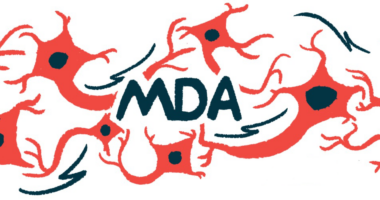Developing Motor Neurons in SMA Show Altered Protein Production

Motor neurons derived from people with spinal muscular atrophy (SMA) showed changes in protein production at each stage of their development, from stem cells to fully mature nerve cells, a study discovered.
Findings in this reported first-such study can be used to identify protein alterations that occur before the onset of symptoms, its scientists noted. They may also be useful as new biomarkers of disease processes or patient response to treatment, or as targets for therapy candidates.
The study, “Spinal Muscular Atrophy Patient iPSC-Derived Motor Neurons Display Altered Proteomes at Early Stages of Differentiation,” was published in the journal ACS Omega.
SMA is caused by low levels of the survival motor neuron (SMN) protein due to a faulty SMN1 gene. The SMN protein plays an essential role in processing messenger RNA (mRNA), which carries instructions from genes to make proteins.
Although SMN protein is found in every cell type, its lack in motor neurons, the nerve cells that control voluntary muscle movement, leads to the characteristic muscle weakness seen in people with SMA.
Because the SMN protein is essential in the expression (production) of proteins, analyzing the overall changes in protein expression due to SMN deficiency in motor neurons can provide insights into the underlying biology of SMA, especially in its early stages.
Changes to motor neurons can be investigated using induced pluripotent stem cells (iPSCs), which are stem cells created from any cell in the body, and then transformed into motor neurons for further study.
With iPSCs derived from two SMA patients, scientists at the University of Utrecht in the Netherlands generated motor neurons and measured overall protein expression — called the proteome — at every stage of cellular development (neuronal differentiation).
“The aim of our study was to evaluate specific proteome changes that occur during [motor neurons] differentiation of SMA patient and healthy control-derived iPSCs,” the team wrote.
Motor neurons were analyzed at 10 time points — from the stem cell stage (T1 stage) to the fully differentiated, mature motor neuron (T10 stage). As expected, compared with cells from healthy controls, SMN protein levels were lower in cells derived from SMA patients.
LC-MS/MS technology, a powerful technique to analyze proteins, was used to identify 8,049 proteins and measure the levels of 3,658 proteins across all time points.
Overall, the SMA samples were essentially different in protein production from controls, “demonstrating proteome alterations between SMA and control cell lines already at early stages during neuronal differentiation,” the researchers wrote.
Differences in protein expression during cell differentiation showed three distinct clusters between SMA and control cells: the early stages (T2, T3, and T4), when stem cells show neuron-like characteristics; the middle stages (T5, T6, and T7), when cells resemble motor neuron progenitor cells; and the late stages (T8, T9, and T10), as cells move toward fully mature motor neurons.
During cell differentiation, the changes in protein expression between SMA and controls — called differentially expressed proteins — increased over time. About 10% of proteins were differentially expressed at all time points, with most (23.1%) differences occurring during the late maturation stages.
In the early stages, higher levels of proteins within SMA-derived cells (upregulation) were associated with biological processes such as mRNA processing and RNA metabolism. In contrast, a decrease in protein production (downregulation) was tied to protein complex organization, the localization of cellular components, and the metabolic breakdown of molecules.
In the middle stages, SMA-related upregulation was linked to the organization of organelles within cells, intracellular transport, and mRNA processing, whereas downregulated proteins were associated with protein complex organization and the assembly of cellular components.
In the final stages of SMA motor neuron development, upregulated proteins were related to cell localization, the transport of molecules out of the cell, and to the activation of immune cells known as neutrophils. In contrast, protein complex organization, mRNA metabolism, and the production of cellular components were associated with protein downregulation.
Within cells, pre-mRNA is first copied from the gene and then processed into mature mRNA (through a process called splicing) before being used as a template to make proteins. SMN is one of the proteins that form the SMN complex, which together processes pre-mRNA. For this reason, the team assessed proteins that directly interacted with SMN.
A total of 20 SMN binding partners with a role in RNA processing were identified, of which 13 were found in the proteomics measurements during motor neuron differentiation. These included: SMN, GEMIN3, GEMIN4, GEMIN5, WDR77, DICER1, PFN1, and HNRNPUL1.
Alterations to many of these SMN binding partners, on their own, also result in motor deficits, the researchers noted. This suggests that “inadequate levels of any one member rather than SMN only is sufficient to arrest the SMN complex and the normal motor neuron development,” they wrote.
The scientists then showed that the majority of proteins associated with splicing were downregulated in SMA compared to healthy controls, and altered production patterns were already present during the early stages of motor neuron differentiation, “suggesting that splicing dysregulation may be an early hallmark of SMA,” they added.
Overall, the results showed “that SMA [motor neuron] proteomes are different from control [motor neuron] proteomes at early stages of [motor neuron] differentiation,” the researchers concluded.
“Efforts to improve SMA therapy can potentially benefit from … strategies that combine SMN-elevating drugs with therapies that target specific mechanisms at early stages of the disease,” they added. “The findings described here can be used to identify proteins that are changed before the onset of disease symptoms and could be used to screen for a novel biomarker and/or therapeutic candidates.”








